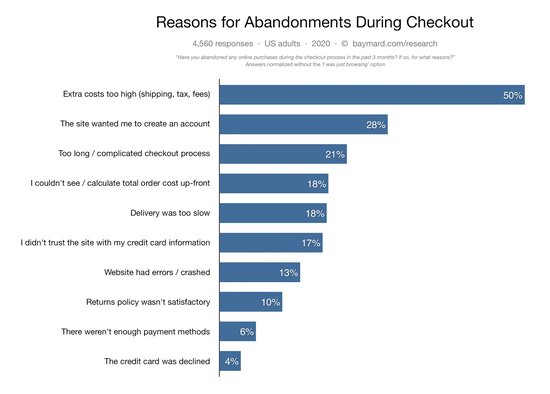eCommerce Shopping Cart Abandonment Rate
The check-out process is of the utmost importance for eCommerce websites, as fully 80% of online shoppers have placed items in the shopping cart and left the site without making a purchase. This represents a huge lost opportunity for online stores.
Among shoppers that have abandoned their shopping cart, shipping costs were the reason cited most often.
The typical shopping cart abandonment rate for online stores varies between 60% and 80%, with an average of 67.91%.
Mobile eCommerce shopping cart abandonment rates are as high as 85.6% in some studies.
Your shopping cart abandonment rate may not mirror this exactly; it varies depending on industry and products. But, if you sell something online, abandoned shopping carts are something you’re going to want to track and address.
It’s claimed that the best optimized checkout process has a shopping cart abandonment rate of 20%.
To achieve such optimization, eCommerce websites use shopping cart features and recovery strategies that are developed to improve conversion rates.
BI Intelligence estimates the revenue lost to abandoned carts at an eye-opening $4.6 trillion.
Research consistently confirms that most shopping cart abandonment occurs because of glitches or frustrations encountered during the checkout process.
 For example, in a recent survey, 50% of customers abandoning carts cited unexpected shipping costs at checkout, followed by being required to create an account (28%), complicated checkout process(21%), card security concerns (17%), and website errors (13%). Another 6% said they weren’t enough payment method options.
For example, in a recent survey, 50% of customers abandoning carts cited unexpected shipping costs at checkout, followed by being required to create an account (28%), complicated checkout process(21%), card security concerns (17%), and website errors (13%). Another 6% said they weren’t enough payment method options.
Why Shoppers Abandon Carts
You don’t have to wonder why shoppers abandon carts. It’s not a secret– the data is well known.
The biggest reason that shoppers abandon carts is unexpected added costs like shipping. But did you know that shoppers will also abandon a cart because they have to create an account to complete their purchase?
As you can see from the data above, a large percentage of shoppers will walk away from a purchase if there isn’t a guest checkout option or if the checkout process is too complicated.
Why shoppers abandon carts / abandoned cart reasons
There are various reasons behind the high cart abandonment rate. In general, these reasons can be categorized as different risks that affect the customer’s decision to ultimately complete the purchase. The following are reasons that were identified in an empirical study.
- Hidden extra costs that are revealed at the time of checkout like high shipping, taxes or fees.
- No option to check out as a guest without creating an account.
- Lengthy / Complicated checkout process.
- Order total not always visible
- Slow estimated delivery time
- Security / privacy concerns
- Website errors
- Unsatisfactory return policy
- Limited payment options.
- Declined credit card
- Desire to wait for a lower/sale price
- Difference in product description versus actual product
What do all of these cart abandonment reasons have in common? All of them can be addressed and corrected with relatively simple modifications to your checkout process.
- Eliminate surprise costs for shipping, taxes, and fees (or offer free shipping over a particular amount)
- Enable guest checkout
- Create a single page checkout and make it very easy to use
- Enable multiple payment options
- Keep the cart visible
- Always show the cart total
- Display site security seals and trust badges
- Ensure accurate product descriptions
Establishing Trust Through Security and Transparency
With consumers regularly using comparison shopping sites, and news of hacking and personal information theft on the rise, eCommerce conversion rates and sales performance hinge more than ever on providing a technically secure system, and also establishing trust through fair, transparent business practices.
Not surprisingly, concerns about personal data security and pricing are very much on the minds of most online shoppers. Fully 92% have concerns when shopping on new or unknown websites, and 83% worry about their identity being stolen through an online purchase.
Handle checkout errors properly: The importance of handling shopping cart form input errors effectively cannot be overstated. Errors occurring in the payment step, in particular, can kill conversion rates, especially when the error messages don’t help the shopper quickly fix the problem.
It’s best to address each error individually and offer precise instructions for correction as shoppers progress through the form, by using inline validation and displaying clear error messages dynamically next to the line, rather than highlighting multiple mistakes on the form at the end.
Baymard co-founder Christian Holst stresses that eliminating ambiguity is crucial: For example, instead of an “invalid phone number” message, provide the user with the actual validation rule, such as “phone number can only contain 10 digits.”
Enable editing of the cart during checkout: Make it easy and intuitive to change size or color choices or quantities, as well as easy to remove items from the cart.
Provide key options and assistance:
- Offer multiple payment options.
- Provide email and phone contacts, and visible order-assistance tools like FAQs, live chat, email support and toll-free numbers.
- Make gift options clear and easy to use.
- Show thumbnail photographs of each item in the basket.
Don’t ask for extraneous or redundant information: Don’t risk driving off prospective customers by testing their patience or raising privacy concerns with requests (or worse, demands) for information that’s useful for your company’s marketing operations, but not required for the actual transaction.
Once you have loyal customers, there are a variety of techniques for encouraging them to provide more in-depth information.
The minimum number of form fields should be visible (asking only for email, name, address and credit card number), and if more are really necessary, reveal the fields a few at a time as checkout progresses.
If you do ask for information like a phone number, explain why in the text near the field, and seriously consider making it optional.
Shoppers should not see fields that are irrelevant to them. They should not be asked to enter any information more than once, or enter information that should already be saved in the system through a previous account set-up.
An auto-fill function that lets users select an address after typing a few characters or words is strongly recommended, particularly with mobile shopping.
Keep the process logical and linear: If shoppers are directed to a separate sub-page (for creating an account or providing a preferred shipping address, for example), don’t redirect them back to a previous page/checkout step; instead, direct them to the next step.
To avoid having shoppers leave the checkout to find coupons, don’t have a coupon field exposed. Instead, enable those who do have a coupon to use a link that exposes the coupon field.
Provide prominent links or buttons to return to shopping.
Create clear labels, instructions and error messages: Provide clear, unambiguous labels next to form fields, and supplement these with “What’s this?” links or brief, small-type explanations.
Don’t assume that the wording of labels or instructions are obvious. In place of vague words like “continue” and “back,” instead use phrases like “shop more” and “check out now.”
Testing and analyzing the experiences of real shoppers on your site will reveal a form’s clarity and usability flaws.
Conclusion
All of the reasons for your eCommerce shopping cart’s abandonment can be addressed and corrected with relatively simple modifications to your checkout process, by following well known best practices.
Contact us for a free evaluation of your eCommerce shopping cart or website.



